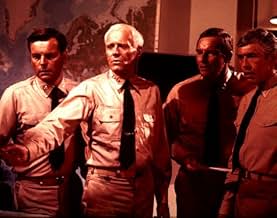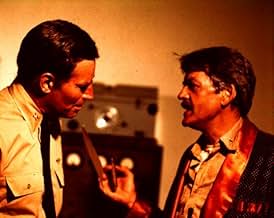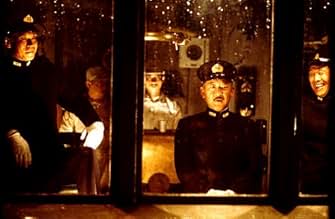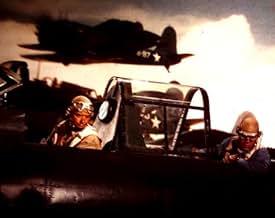CALIFICACIÓN DE IMDb
6.8/10
23 k
TU CALIFICACIÓN
Una dramatización de la batalla que fue proclamada como el punto clave en el desarrollo del frente del Pacífico en la segunda guerra mundial.Una dramatización de la batalla que fue proclamada como el punto clave en el desarrollo del frente del Pacífico en la segunda guerra mundial.Una dramatización de la batalla que fue proclamada como el punto clave en el desarrollo del frente del Pacífico en la segunda guerra mundial.
- Dirección
- Guionista
- Elenco
Toshirô Mifune
- Admiral Isoroku Yamamoto
- (as Toshiro Mifune)
- Dirección
- Guionista
- Todo el elenco y el equipo
- Producción, taquilla y más en IMDbPro
Opiniones destacadas
Of course "Midway" is a flawed movie. The subplot about Japanese-Americans is ridiculous and seems like a forced attempt to be PC during the post-Vietnam 1970s when it wasn't in fashion to be completely celebratory of America. Of course it's unsatisfying that the Japanese actors don't speak Japanese and we have to hear Paul Frees dubbing Toshiro Mifune. Of course the stock footage isn't going to please aviation and naval buffs who know these details like the back of their hands, but to me this is a trivial complaint that fails to take into account the limits of 1970s technology or budgeting. "Pearl Harbor" ultimately got those details right through CGI and the end result was a far worse film in the final analysis. Because ultimately, for all the flaws that are in "Midway" it succeeds because it does stick to the essential truths when telling the story of the battle, and I know this because when I first saw this movie on the CBS Late Movie around 1979, I got so hooked that I went out and read every book on the battle I could find including Walter Lord's "Incredible Victory." The movie had given me a starting reference point and while I was sorry that some key aspects of the latter stages of the battle were not depicted (such as the torpedoing and eventual sinking of the Yorktown), I couldn't have asked for anything better in terms of getting me to learn more about this great turning point of World War II. As far as I'm concerned, it's good that Hollywood did tackle this subject in an era when the influence of "Tora! Tora! Tora!", "The Longest Day" etc. still hung over the proceedings because if it hadn't been made back then, we would today be forced to see it given the "Pearl Harbor" and "Titanic" treatment that is pure garbage.
John Williams contributes one of his finer pre-Star Wars scores with two great themes, the "Midway March" (which is only heard in the end credits of the theatrical version and became more popular in an expanded concert arrangement by the Boston Pops) and the "Men Of The Yorktown March" which dominates much of the score and offers great foreshadowings of the Throne Room sequence in "Star Wars" and the Smallville music in "Superman."
John Williams contributes one of his finer pre-Star Wars scores with two great themes, the "Midway March" (which is only heard in the end credits of the theatrical version and became more popular in an expanded concert arrangement by the Boston Pops) and the "Men Of The Yorktown March" which dominates much of the score and offers great foreshadowings of the Throne Room sequence in "Star Wars" and the Smallville music in "Superman."
A critical part of WWII gets the big epic cinematic treatment, with all star casting and lots of noise. Though purporting to be exactly how things were during this particular battle, a pinch of salt is also needed. Much of the film is taken up with laying foundations for the air-sea engagement of the title, political posturing and military machinations are joined by needless sub-plots. The dialogue is often cheese laden, some characterisations equally so, while the splicing of real life footage and other war movie moments start to detract. However, the last third of film is thrilling and worth waiting for, a whirl of battle action as the Pacific conflict comes vividly to life both visually and aurally. 6.5/10
I can't help but agree with most of the other comments: the sloppy production values, the scenes "borrowed" from better movies, the countless anachronisms, the distracting subplot about Lt. Garth and his Japanese girlfriend, and so on. But for me, this movie has two strong points in its favor. One, when they get around to the actual battle, they follow the history with surprising accuracy. (The "Pearl Harbor" makers could have learned something from this one.) So the movie's hard to follow? So was the actual battle! Personally, I think they did a pretty good job of keeping the flow coherent while still remaining faithful to its source material.
The second thing in its favor is that, from the moment I first saw it in the theater as a 10 year old, it ignited in me a passion for the Battle of Midway that remains to this day. I can't think of any other movie that even comes close to getting me as hooked on its subject as this one. Maybe it's a good thing I first saw it when I was young, when I was much less discerning about production values, etc. That way, I could concentrate on the story itself.
If you have even the slightest interest in military history or even in important historical events in general, do yourself a favor. Watch "Midway" to get an overview of the event (fast-forward over the love-story scenes if you like), then go read "Incredible Victory" by Walter Lord (which is a better book than the one for which he is most famous, "A Night to Remember"). You won't be sorry.
The second thing in its favor is that, from the moment I first saw it in the theater as a 10 year old, it ignited in me a passion for the Battle of Midway that remains to this day. I can't think of any other movie that even comes close to getting me as hooked on its subject as this one. Maybe it's a good thing I first saw it when I was young, when I was much less discerning about production values, etc. That way, I could concentrate on the story itself.
If you have even the slightest interest in military history or even in important historical events in general, do yourself a favor. Watch "Midway" to get an overview of the event (fast-forward over the love-story scenes if you like), then go read "Incredible Victory" by Walter Lord (which is a better book than the one for which he is most famous, "A Night to Remember"). You won't be sorry.
This was one of my favorite movies when I was growing up and building models of land, sea, and air craft of the WWII period. Of course we all could have done without the romantic interest, but what counts is the overall telling of the story accurately (even if that includes sideline dramatizations etc.). In a nutshell Midway was a gamble and even though we knew where they'd be, we still took it on the chin with the loss of most of the aircraft and the Yorktown (which left only 2 effective carriers in the pacific and 1 in drydock). In the end we were lucky enough to be able to inflict sufficiently more damage on them than they did on us. This is the story that is told so well. It doesn't matter that the special effects were less than stellar (e.g., view of the fleet from the sealevel - obvious miniatures) or that they showed Essex class carriers which did not yet exist getting hit by kamikaze. The film is true in its depictions of gambles, gaffs, and good fortune which in the end allowed us to be victorious and end Japanese expansion. So quit knocking it and enjoy it for what it is!
I first saw this movie when it was opening as a 10 year old boy who was enamored with WWII. At that time to me, it was one of the best war movies I had ever seen. Due to my prior readings on the battle, I knew it followed the history fairly well, and I was able to tune out the romance sub plot. The look of movie was something that was something I was not familiar with in war movies up to that point. The indoor officers were in nice neat uniforms, while the pilots, Marines, and common sailors had a weary rumpled look. And the language! I had not yet heard so much cursing in a war movie (it was 1976 and for the most part John Wayne type movies were the norm). But I loved it all! I knew most of the planes shown on screen were not accurate, and much of the combat footage was from later in the war. But it showed a different type of war movie. The Japanese were strong, smart, and nearly invincible. Not monsters or maniacs, but allowing overconfidence at times to cloud some decisions. The Americans were brave, novices, unsure of themselves at times, yet determined not to fail, no matter the cost. Not the overpowering unbeatable force of years to come later in the war. Watching during the initial phases of combat as obsolete US planes were shot down one by one by the superior Japanese fighters, I was captivated by the self sacrifice(a year later the ending dogfight in Star Wars would make me think of Torpedo 8). Then the tide turned as events, luck, and timing change the course of battle. In the end, the US wins, the Japanese are defeated, and survivors ponder the results and reasons why briefly. Flash forward 32 years later and I watch this movie again on my DVD copy on the 66th anniversary of the battle. This movie holds up not too badly against the test of time. Much time has passed in by movie making and in my gaining knowledge of this subject. To me the strengths still hold, as do the weaknesses. The interracial romance subplot is certainly a 70s addition. Certainly not believable in a historical context. The stock footage of aircraft certainly still glares in error as well. Color footage was shot during the battle and released in a documentary. A small amount was incorporated into the movie. Much more could have replaced other sequences that were used in the movie. Many of the Tora!Tora!Tora! conversion aircraft were still local to Universal Studios at Orange County or Chino airports at the time of filming. Some were used in the Midway Island bombing sequence, but not in the Yorktown attacks. Too bad they did not make more use of them for a better look. The Japanese film sequences from "Storm Over the Pacific" actually worked very well for their capturing the look of the Japanese carriers and the activities on board. As did the lifted opening from "30 seconds Over Tokyo". Much of the dialog on film is true to life with certain quotes historically accurate. "Look at that b*****d burn", was the first radio message clearly heard on the US carriers letting them know any of the air strikes had made contact and been successful. It also holds up sticking fairly close to the time line of actual events, but there are several events omitted. Finally the effects were not bad. For pre CGI the choices are to build full scale mocks ups, use an area or item that has a resemblance or miniatures. All three methods were used to good effect. And the results were for the most part just as good as, if not better than the more modern (film making wise) CGI heavy "Pearl Harbor". All in all, a decent war movie, still worth watching, flaws and all.
¿Sabías que…?
- TriviaKevin Dobson's character Ensign George Gay, was the sole survivor of Torpedo Squadron 8. Gay wrote a book about his experiences (Sole Survivor) and was an advisor on this film.
- ErroresWhen the cockpit of one of the planes catches fire, the pilot pulls out a fire extinguisher. It is a more modern one, not a fire extinguisher that would have existed in the 1940s.
- Citas
Vice Adm. Chuichi Nagumo: [commenting on the American torpedo bombers] They sacrifice themselves like samurai, these Americans.
- Versiones alternativasA television version exists, with additional cast and plot. It runs four hours with commercials. The main plot points are a Charlton Heston-Susan Sullivan romance and the Coral Sea battle (reffered to in the other version) is played out like the Midway battle. The Coral Sea battle heavily features Mitchell Ryan as Admiral Aubrey Fitch and also includes a subplot where a young Japanese pilot who'd met with Admiral Nagumo to express his opposition to Japanese military action is shot down. At the end of the TV version, Sullivan and Christine Kukobo are both shown waiting dockside.
- ConexionesEdited from Así es la gloria (1943)
- Bandas sonorasIn the Mood
Music by Joe Garland
Performed by the Glenn Miller and His Orchestra (as Glenn Miller Orchestra) on the jukebox at the bar in Hawaii
Selecciones populares
Inicia sesión para calificar y agrega a la lista de videos para obtener recomendaciones personalizadas
- How long is Midway?Con tecnología de Alexa
Detalles
Taquilla
- Total en EE. UU. y Canadá
- USD 43,220,000
- Fin de semana de estreno en EE. UU. y Canadá
- USD 4,356,666
- 20 jun 1976
- Tiempo de ejecución2 horas 12 minutos
- Color
- Relación de aspecto
- 2.39 : 1
Contribuir a esta página
Sugiere una edición o agrega el contenido que falta

Principales brechas de datos
By what name was La batalla de Midway (1976) officially released in India in English?
Responda





































